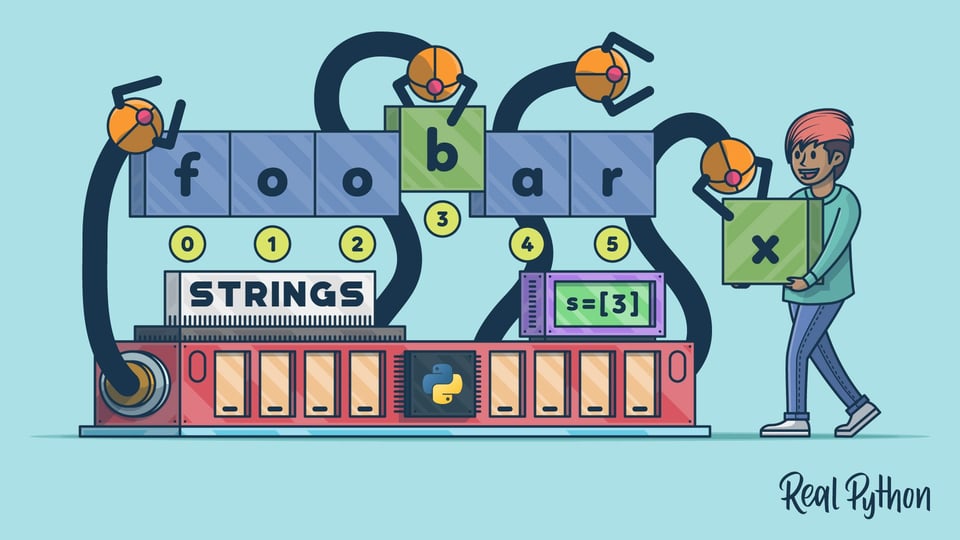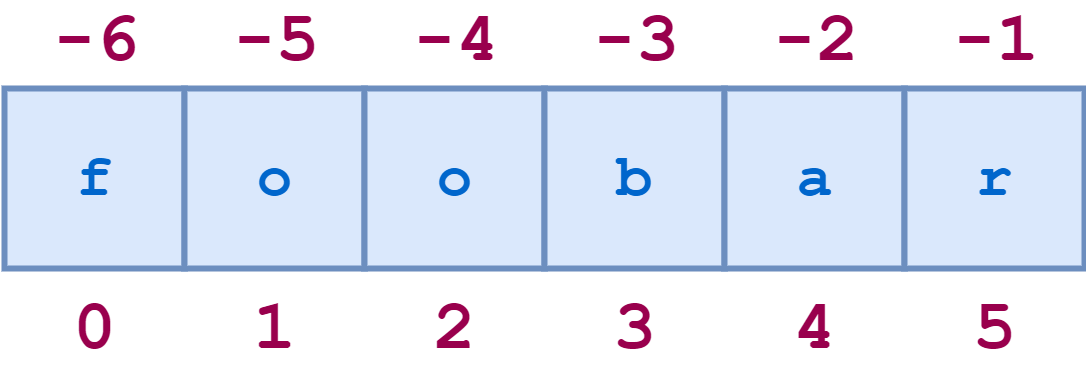 #
#
#  #
#
| Name | #Type in Python | #Description | #Example | #
|---|---|---|---|
| Strings | #str | #Ordered sequence of characters, using the syntax of either single quotes or double quotes. | #'hello' "Hello" "i don't do that" "2000f" | #
| Special Escape Character | #Result | #
|---|---|
| \n | #New Line | #
| \t | #Tab | #
#  #
#
name_of_string[n-1]
# In[15]:
#Show first element
a[0]
# In[16]:
#Show second element
a[1]
# To get a portion of a string, we can use slicing with the colon `:`.
#
# In general if you want to get everything from nth index to mth index use name_of_string[n:m+1]
# In[17]:
a[2:7]
# In[18]:
#Grab everything past the first term all the way to the length of a which is len(a)
a[1:]
# In[19]:
#Grab every characters up to the 3rd index
a[:3]
# In[20]:
#Grab Everything
a[:]
# In[21]:
a[len(a)-1]
# String indices can also be specified with negative numbers, in which case indexing occurs from the end of the string backward: -1 refers to the last character, -2 the second-to-last character, and so on.
#
#
#  #
#
# In[22]:
#Last Chatacter (one index behind 0 so it loops back around)
a[-1]
# In[23]:
a[-3]
# In[24]:
a[-len(a)]
# In[25]:
#Grab everything but the last Character
a[:-1]
# In[26]:
a
# In[27]:
print(a[-5:-2])
print(a[20:23])
a[-5:-2] == a[20:23]
# Slicing can also have a third elememnt.
#
# `[start:stop:step]`
#
# - start: numerical index for the slice index
# - stop: index you will go up to but not include
# - step: the size of jump you take
# In[28]:
a[::1]
# In[29]:
#Grab everything, but go in step sizes of 2
a[::2]
# You can specify a negative step value as well, in which case Python steps backward through the string. In that case, the starting/first index should be greater than the ending/second index.
# In[30]:
a[6:0:-2]
# This is a common paradigm for reversing a string.
# In[31]:
a[::-1]
#
#
# ## 2.5. String Properties:
# - **immutability**: Strings in Python are immutable, meaning you can't change individual characters within them once they're created.
# In[32]:
#Let's try to change the first letter to 'c'
a[0] = 'c'
# In truth, there really isn’t much need to modify strings. You can usually easily accomplish what you want by generating a copy of the original string that has the desired change in place. There are very many ways to do this in Python. Here is one possibility:
# In[33]:
'c' + a[1:]
# - **concatenate**: Concatenation refers to the process of joining two or more strings together to form a new, longer string. In Python, you can concatenate strings using the addition operator `+`.
# In[34]:
a + a
# In[35]:
a + ' ' + a
# In[36]:
a + ' New Sentence'
# In[37]:
a[:3] + a[3:]
# In[38]:
a
# The original a string is unchanged until you reassign a.
# - **Reassignment**
# In[39]:
a = a + ' New Sentence!'
# In[40]:
print(a)
# - **Repetition**: In Python, strings support the repetition property, which allows you to create new strings by repeating an existing string multiple times. This is achieved using the multiplication operator `*`.
# In[41]:
a * 2
#
#
# ## 2.6. String Operators:
# - **`in`**: Python also provides a membership operator that can be used with strings. The in operator returns True if the first operand is contained within the second, and False otherwise.
# In[42]:
'W' in a
# In[43]:
'b' in a
# - **`not in`**: The not in operator returns True if the first operand is not contained within the second, and False otherwise.
# In[44]:
'W' not in a
# In[45]:
'b' not in a
# There are also comparison operators which will be discussed later.
#
#
# ## 2.7. Built-in String Methods:
# Objects in Python have built-in functions called methods. These methods are functions inside the object (we will learn about these in much more depth later) that can perform actions or commands on the object itself.
#
# We call methods with a period and then the method name. Methods are in the form:
#
# `object.method(parameters)`
#
# Where parameters are extra arguments we can pass into the method.
#
#
#
# Method
# Description
#
#
#
#
# upper()
# upper case a string
#
#
# lower()
# lower case a string
#
#
# split()
# Split a string by blank space
#
#
# split(m)
# Split a string by the element m (doesn't include the element that was split on)
#
#
# replace(oldvalue,newvalue,count(optional))
# replaces a specified phrase with another specified phrase
#
#
# capitalize()
# first character converted to uppercase and all other characters converted to lowercase
#
#
# swapcase()
# uppercase alphabetic characters converted to lowercase and vice versa
#
#
# title()
# first letter of each word is converted to uppercase and remaining letters are lowercase
#
#
# count(m,a(optional),b(optional))
# number of occurrences of m within the substring indicated by a and b
#
#
# endswith(m,a(optional),b(optional))
# returns True if an string ends with m within the substring indicated by a and b
#
#
# find(m,a(optional),b(optional))
# see if a string contains a m within the substring indicated by a and b and returns the lowest index
#
#
# rfind(m,a(optional),b(optional))
# see if a string contains a m starting at the end within the substring indicated by a and b and returns the lowest index
#
#
# index(m,a(optional),b(optional))
# the index of first occurrence of m for a given substring indicated by a and b
#
#
# rindex(m,a(optional),b(optional))
# the index of first occurrence of m starting at the end for a given substring indicated by a and b
#
#
#
# In[46]:
a
# In[47]:
a.upper()
# In[48]:
a.lower()
# In[49]:
a.split()
# In[50]:
a.split('b')
# In[51]:
a
# In[52]:
a.replace('b','c')
# In[53]:
a.replace('b','c',1)
# In[54]:
a.capitalize()
# In[55]:
a.swapcase()
# In[56]:
a.title()
# In[57]:
a.count('b')
# In[58]:
a
# In[59]:
a.count('b',0,3)
# In[60]:
a.endswith('!')
# In[61]:
a.endswith('!',0,3)
# In[62]:
a.find('Sentence!')
# In[63]:
a.find('b')
# In[64]:
a.rfind('b')
# In[65]:
a.index('b')
# In[66]:
a.rindex('b')
# `.rindex()` is identical to `.rfind()`, except that it raises an exception if m is not found rather than returning -1.
# In[67]:
a.rindex('x')
# In[68]:
a.rfind('x')
#
#
# ## 2.8. String Formatting:
# **`.format()`**: We can use the `.format()` method to add formatted objects to printed string statements.
# In[69]:
'Insert another string with curly brackets: {}'.format('The inserted string')
# **f-string**
# In[70]:
n = 23
m = 25
prod = n * m
print(f'The product of {n} and {m} is {prod}')